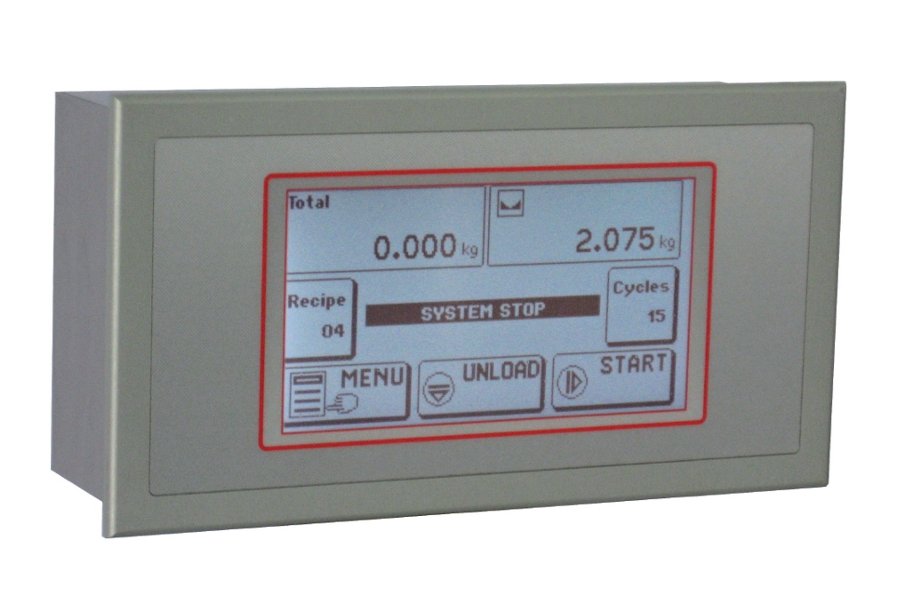TOUCH SCREEN ANZEIGEGERÄT
LCD-Display 5.2 – graphische Darstellung, Touchscreen, einfarbig mit hohem Kontrast. Verwaltung von 2 Kanälen für Wägezelle und Eingang für Inkrementalencoder, doppelter Analogausgang und zusätzlicher Analogeingang. 6 Output und 6 Input, integriert, kann mit externen Modulen erweitert werden.
Integrierte Kommunikationsschnittstellen Rs232, Rs485, USB, Ethernet, Modbus; Profibus DP mit externem Modul. Optioneller USB-Host-Port zur Verbindung eines USB-Keys zur Datenspeicherung, Archive hochladen, kundenspezifische Einstellungen.
Installationsanleitung herunterladen ![]()
Bedienungsanleitung herunterladen ![]()
![]() Zur Vergrößerung auf das Bild klicken
Zur Vergrößerung auf das Bild klicken

| Stromversorgung | 24 V cc ± 15 % | |
| Stromaufnahme max | 10 W | |
| Installationskategorie | Cat. II | |
| Betriebstemperatur | -10 / +50 °C (14 / 122 °F) Maximal 85% nicht kondensierend | |
| Lagertemperatur | -20 / +60°C (-4 / +140°F) | |
| Display | LCD 5,2“ (sichtbarer Bereich 118 x 58 mm) Monochrom mit hohem Kontrast | |
| Display-Helligkeit | Hintergrundbeleuchtung Weiße LEDs, Intensität einstellbar | |
| Touchscreen | Resistiv 4 Drähte, geeignet für die Verwendung mit Handschuhen, Summer | |
| Bohrschablone | 187 x 97 mm / 7.36 x 3.82 in (l x h) | |
| Außenmaße | 196 x 105 mm / 7.72 x 4.13 in (l x h) | |
| Montage | Eingebaut in Frontplatte | |
| Schutzklasse | IP 65 | |
| Anschlüsse | Abnehmbare Schraubenklemmleisten Schritt 5.08 / 7.5 mm, USB-Verbinder ( Host / Device ) Standard-Verbinder Ethernet Standard RJ45 | |
| Eigenschaften des Zelleneingangs | 2 Eingangskanäle für Wägezellen. Akquisition alternativ oder simultan mit reduzierter Frequenz | |
| Stromversorgung der Wägezellen | 5 V Gleichstrom / 120 mA (maximal 8 Zellen mit 350 Ω parallel) gegen Kurzschluss geschützt | |
| Eingangsempfindlichkeit | 0.02 µV min | |
| Linearität | < 0.01% des Skalenendwertes | |
| Temperaturabweichung | <0,0003% des Skalenendwertes/°C | |
| Interne Auflösung | 24 bit | |
| Gewichtsauflösung | Bis zu 600.000 Divisionen der Nutzlast | |
| Messbereich | -7.8 mV/V - +7.8 mV/V | |
| Häufigkeit der Gewichtserfassung | 12.5 Hz - 250 Hz | |
| Digitalfilter | 0.2 Hz - 50 Hz | |
| Kommunikationsschnittstelle | 3 unabhängige Kommunikationsports (nicht geschaltet) | |
| Maximale Kabellänge | 15 m (Rs232), 1000 m (Rs485) | |
| Serielle Protokolle | TCP/IP, UDP, ARP, ICMP, ModBus/TCP | |
| Baudrate | Aus 1200 zu 115200 bit/sec | |
| Optionen | USB-Flash-Laufwerk-Schnittstelle mit FAT16 / FAT32 Dateisystem-Management | |
| Mikrokontroller | RISC 32 bit, 44 MHz | |
| Speicher Programmcodes | Flash 256K Bytes, programmierbar on board (Rs232, USB) | |
| Datenspeicher | 1088 Kbytes Standard, kann bis auf 2113 Kbytes erweitert werden | |
| Kalender | Integriert mit aufladbarer Batterie | |
| Typ | Obere Klemmleiste Schritt 5.08 mm |
| Länge | ND |
| 1 | RS232 Tx COM2 |
| 2 | RS232 Rx COM2 |
| 3 | GND |
| 4 | RS232 Tx PRINT |
| 5 | RS232 CTS |
| 6 | TX+/RX+ RS485 COM2 |
| 7 | TX-/RX- RS485 COM2 |
| 8 | TX+ RS422 COM1 |
| 9 | TX- RS422 COM1 |
| 10 | RX+ RS422 COM1 |
| 11 | RX- RS422 COM1 |
| 12 | Out analog. 1 mA |
| 13 | Out analog. 1 V |
| 14 | Out analog 1 GND |
| 15 | Out analog. 2 mA |
| 16 | Out analog. 2 V |
| 17 | Out analog 2 GND |
| 18 | In analog. Volt |
| 19 | In analog. GND |
| 20 | Encoder power |
| 21 | Encoder GND |
| 22 | Encoder Phase A |
| 23 | Encoder Phase B |
| Typ | Untere Klemmleiste Schritt 5.08 mm |
| Länge | ND |
| 1 | - Exc. Load cell |
| 2 | + Exc. Load cell |
| 3 | + Ref. Load cell |
| 4 | - Ref. Load cell |
| 5 | Load cell 1, signal - |
| 6 | Load cell 1, signal + |
| 7 | Load cell 2, signal + |
| 8 | Load Cell 2, signal - |
| 9 | Input 1 |
| 10 | Input 2 |
| 11 | Input 3 |
| 12 | Input 4 |
| 13 | Input 5 |
| 14 | Input 6 |
| 15 | Common input |
| 16 | Output 1 |
| 17 | Output 2 |
| 18 | Output 3 |
| 19 | Output 4 |
| 20 | Output 5 |
| 21 | Output 6 |
| 22 | Common output |
| Typ | Untere Klemmleiste Schritt 7.5 mm |
| Länge | ND |
| 23 | Power supply 24 Vdc |
| 24 | GND |
General precautions to be followed in the installation and assembly of load cells: